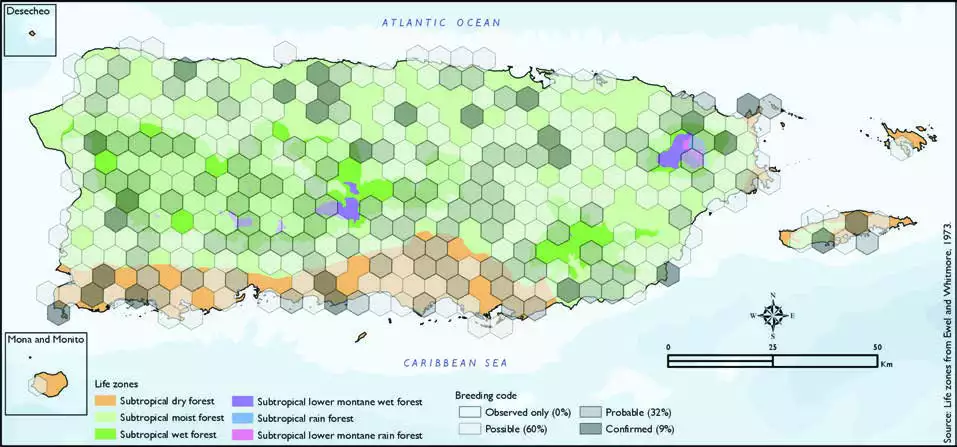Shiny Cowbird
Description
The shiny cowbird (Molothrus bonariensis) is a passerine bird in the New World family Icteridae. It breeds in most of South America except for dense forests and areas of high altitude such as mountains. Since 1900 the shiny cowbirds' range has shifted northward, and it was recorded in the Caribbean islands as well as the United States, where it is found breeding in southern Florida. It is a bird associated with open habitats, including disturbed land from agriculture and deforestation.
Physical appearance of the shiny cowbird adult depends on subspecies. Sizes range from 31-40 grams in mass and 18 cm in length (M. b. minimus), to 55-65 grams in mass and 22 cm in length (M. b. cabanisii).
Distribution & Habitat
The Shiny Cowbird is a common resident species native to South
America but has expanded
its distribution range north
throughout the Lesser and Greater
Antilles, The Bahamas, and the
Southern United States (Cruz
and others 1985, Post and Wiley
1977a, Raffaele and others 1998). The cowbird is believed to have
arrived in Puerto Rico before 1955
(Post and Wiley 1977a), where it
is now established (Bond 1961,
Raffaele 1989a) and has also
colonized the island of Culebra
(Sorrié 1975). In Vieques, the
cowbird is an uncommon resident
in spring, summer, and fall, and
rare in winter (Gemmill 2015).
This species occurs mostly near
livestock in open or brushy fields,
but can also be found in gardens,
open forests (Oberle 2018), and
agricultural areas with available
grains (Raffaele and others 1998),
as well as into the mountains
where suitable habitat is available
(Raffaele 1989b, Raffaele and
others 1998). The atlas fieldwork
yielded a total of 502 records
within 317 hexagons or 66
percent of the 479 total hexagons
(see map). Of the 317 hexagons where this species was found,
breeding met the atlas definition of
confirmed in 9 percent (27) of the
hexagons, probable in 32 percent
(101), and possible in 60 percent
(189) (see map).

Breeding Habits
Previously published reports
indicate that the Shiny Cowbird
breeds primarily from March
through July (Raffaele and others
1998). Cowbirds are brood
parasites in which the females
do not build nests, but rather lay
their eggs in the nests of other
species, which serve as foster
parents, incubate the cowbird eggs
and brood, and feed the nestling
and fl edgling cowbirds. Cowbird
nest parasitism has reduced the
nesting success of several host
species including the endemic
Yellow-shouldered Blackbird Shiny Cowbird distribution. The map shows the highest breeding code by hexagon and overlaying the ecological life zones in
Puerto Rico. Note: percentages may not total 100 due to rounding. 269Shiny Cowbird/Tordo Lustroso(Agelaius xanthomus) (Post and Wiley 1977b) and Puerto Rican
Vireo (Vireo latimeri) (Woodworth
1997). The cowbird is a generalist
in terms of host selection as it has
been found to parasitize the nests
of 27 bird species on Puerto Rico,
although these host species differ
in their abilities to successfully
fl edge cowbird young (Wiley
1985). Cowbird breeding tends
to coincide with the breeding
periods of high-quality hosts (i.e.,
those that fl edge >55 percent of
cowbird eggs hatched) and not
with breeding periods of low-
quality hosts (i.e., species that
fl edge <55 percent of cowbird
chicks that hatch) (Wiley 1985).
Atlas results show that this species breeding season extends
throughout the year with the most
breeding activity from March to
June (see chart). The breeding
activity peaks in May during the
onset of the rainy season, and the
overall breeding pattern mostly
takes place in the subtropical
moist forest life zone (see chart).
Results show that this species
breeds mostly in lowlands within
the subtropical moist forest life
zone (58 percent of the hexagons)
(see table and map). However,
results indicate that it also breeds
at higher elevations within the
subtropical wet forest life zones
(22 percent of the hexagons), as
well as in the coastal plains of the
subtropical dry forest life zones (20 percent of the hexagons)
(see table and map).
Conservation
The current population trend for
the Shiny Cowbird is described
as increasing. This species is
currently listed as a species of least
concern by the IUCN (BirdLife
International 2016). Locally, this
species is not listed in any of the
threatened categories of PRDNER
and USFWS. In Puerto Rico, the
Shiny Cowbird has a protected
habitat in land of about 12 percent
or 929 km2 of the total area covered by the hexagons where
evidence of breeding was found
for this species (7582 km2).
Related Species
Family:
icterids